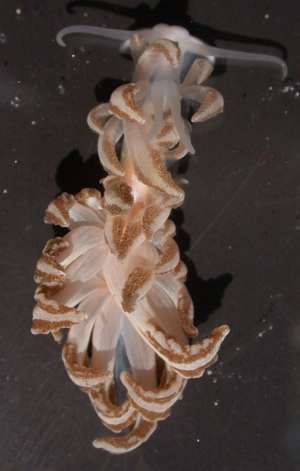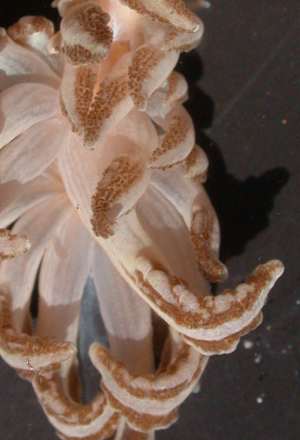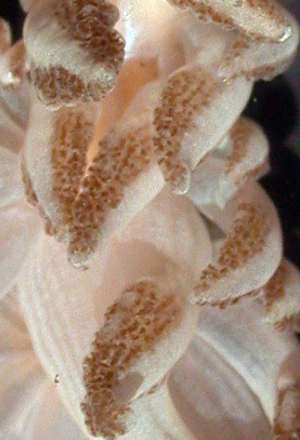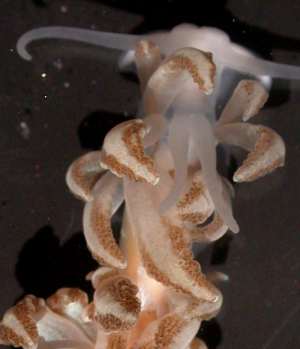Phyllodesmium jakobsenae - ceratal shape
September 1, 2005
From: Bill Rudman

To accompany Ingo Burghardt's message [#13424] concerning Phyllodesmium jakobsenae here are some close-ups from Michael Schrödl's photos to show in more detail the shape and structure of the cerata. Ingo has mentioned the zooxanthellae symbiosis this species has, like many of its genus and the cerata have evolved to undertake the joint function of camouflaging the animal by making it look like part of the Xenia colony, and to provide a 'farm' where the sumbiotic zooxanthellae can live and photosynthesise. The brown patches on each side of the cerata certainly create the illusion of a thin pale tentacle Xenia tentacle. And amazingly the brown patches are in fact the zooxanthellae 'gardens'. In close-up we can see that in each patch there are dark brown spheres which I assume are the sacs packed full of zooxanthellae much like the sacs in the tentacles of Xenia that I have illustrated in the zooxanthellae in cnidarians Fact Sheet.
To quote from Burghardt & Wägele, (2004) " In P. jakobsenae the branching of the digestive gland shows unique features for the
Xenia-feeding Phyllodesmium species: The fine ducts terminate in sac-like structures and these are mainly concentrated on the flattened side of the ceras orientated towards the light."
Locality: Bunaken Island, North Sulawesi, Indonesia. intertidal. Length: up to 30 mm. 12 July 2003. intertifdal coral reef with patches of sea grass. Photographer: Michael Schrödl
-
Burghardt, I. and Wägele, H. (2004) A new solar powered species of the genus Phyllodesmium Ehrenberg, 1831 (Mollusca: Nudibranchia: Aeolidoidea) from Indonesia with analysis of its photosynthetic activity and notes on biology. Zootaxa, 596: 1-18.
Cheers,
Bill Rudman



This photo shows the smooth rhinophores, long tentacular oral tentacles and pointed recurved anterior foot corners.
Bill Rudman
Related messages
-
Phyllodesmium jakobsenae - a new species from Indonesia
From: Ingo Burghardt, September 1, 2005 -
Phyllodesmium jakobsenae from Philippines
From: Jeff Rosenfeld, September 1, 2005 -
Phyllodesmium jakobsenae - radula and jaw morphology
From: Ingo Burghardt, September 1, 2005
